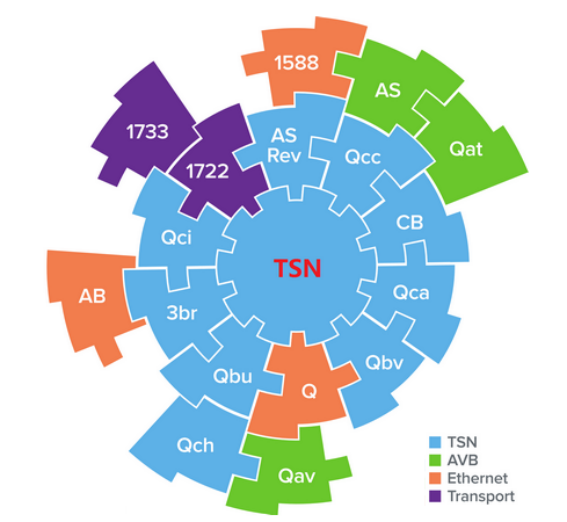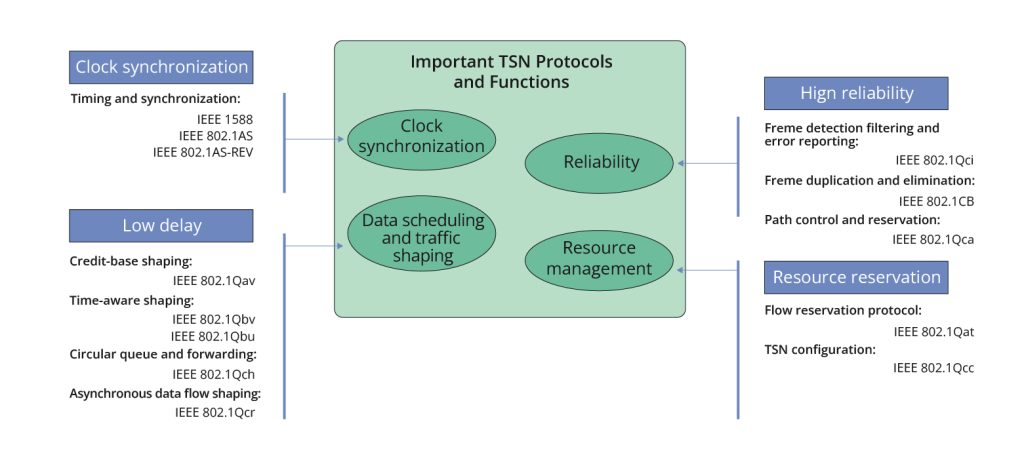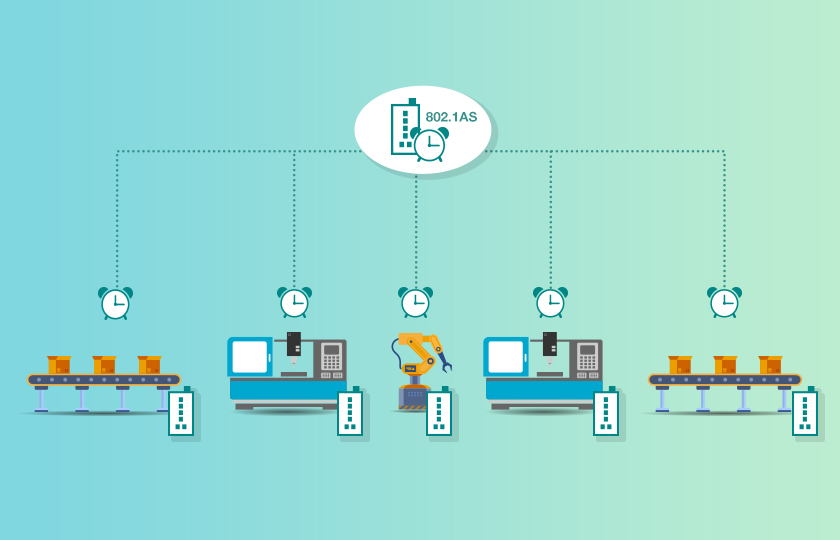Time-Sensitive Networking (TSN): Enabling Deterministic Ethernet
What is TSN?
Time-Sensitive Networking (TSN) is a set of protocol standards developed by IEEE 802.1 that enables deterministic communication with minimal latency over non-deterministic Ethernet networks. TSN provides a universal time-sensitive mechanism for the data link layer of Ethernet protocols, offering determinism and reliability to standard Ethernet to ensure real-time, deterministic, and reliable data transmission while improving transmission efficiency. Additionally, TSN enables both time-sensitive (high real-time requirements) and non-time-sensitive data to be transmitted over the same network.

Key TSN Protocols
Traditional Ethernet employs Carrier Sense Multiple Access/Collision Detection (CSMA/CD) mechanisms, where workstations must delay and retransmit packets after collisions. During congestion, some packets may experience significant transmission delays, causing communication timing uncertainty. Previously, data with high real-time requirements was transmitted through specialized real-time Ethernet systems.
This separation created significant challenges during the convergence of Information Technology (IT) and Operational Technology (OT). To satisfy real-time and deterministic data transmission requirements, time-sensitive and non-time-sensitive data often required transmission over two separate networks. Controllers typically featured two network ports: one for real-time Ethernet and another for standard Ethernet. TSN not only ensures real-time and deterministic data transmission but also enables both time-sensitive and non-time-sensitive data to be transmitted over a single network.
TSN achieves real-time, deterministic data transmission through a set of protocol standards (the TSN protocol family), ensuring smooth transmission of time-sensitive information across different standard Ethernet scenarios. The TSN protocol family offers high flexibility, allowing users to select appropriate protocol combinations based on specific application requirements. The TSN protocol family encompasses four categories of sub-protocols: time synchronization, data scheduling and traffic shaping, reliability, and resource management.
Time Synchronization
Unlike standard IEEE 802.3 Ethernet, time plays a crucial role in TSN networks. For real-time communication, end-to-end transmission delays have non-negotiable time boundaries, requiring all TSN devices to share a common time reference model and synchronize their clocks. TSN currently implements time synchronization using IEEE 1588 and IEEE 802.1AS protocols.

The IEEE 1588 protocol, known as the Precision Time Protocol (PTP), synchronizes clocks in computer networks. In local area networks, it can maintain clock accuracy within the sub-microsecond range, making it suitable for measurement and control systems.
Data Scheduling and Traffic Shaping
TSN defines various shaping mechanisms to constrain data flow latency within specific ranges, addressing different low-latency scenario requirements. In traditional Ethernet, data flow communication latency is unpredictable. Due to this uncertainty, data receivers typically need large buffer zones, which compromises the real-time characteristics of data flows such as audio and video streams. TSN not only guarantees the arrival of time-sensitive flows but also ensures their low-latency transmission. By optimizing the transmission of time-sensitive flows, best-effort flows, and other data flows throughout the network, TSN ensures data flow transmission time requirements are met. This optimization control method is known as shaping.
TSN protocols for data scheduling and traffic shaping include IEEE 802.1Qav, IEEE 802.1Qbv, IEEE 802.1Qbu, IEEE 802.1Qch, and IEEE 802.1Qcr. Among these, IEEE 802.1Qbv employs non-preemptive data scheduling with traffic scheduling controlled through time slots. Time-sensitive data flows are transmitted with priority, while bandwidth is reserved for best-effort data and reserved data, allowing time-sensitive and non-time-sensitive flows to transmit over the same network while ensuring real-time data transmission.

Using IEEE 802.1Qbv, packet transmission is arranged end-to-end within a repeating cycle. IEEE 802.1Qbv defines three basic traffic types: time-sensitive flows, best-effort flows, and reserved traffic. Time-sensitive flows are suitable for critical messages with strict real-time requirements, while best-effort flows are general Ethernet traffic requiring no Quality of Service (QoS). Reserved traffic is appropriate for frames needing specific bandwidth reservation with soft real-time requirements.
IEEE 802.1Qbv defines gates that enable or disable frame transmission through scheduling algorithms, dividing Ethernet communication into fixed-length, continuously repeating cycles. These cycles are divided into time slots, and data is assigned different priorities to enable transmission in designated slots. With this operation, time-sensitive flows can have dedicated time slots, ensuring deterministic transmission over traditional Ethernet networks. Reserved traffic and best-effort flows occupy the remaining time slots in each cycle, with reserved traffic guaranteed dedicated bandwidth while best-effort flows use remaining bandwidth.
Since TSN operates based on different time slots for different types of traffic, all network devices must be synchronized within nanosecond ranges.
Reliability
Applications with high real-time data transmission requirements need not only timely data transmission but also highly reliable transmission mechanisms to address issues such as bridge node failures, line breaks, and external attacks, ensuring functional safety and network security. IEEE 802.1Qci, IEEE 802.1CB, and IEEE 802.1Qca implement these performance aspects in TSN.
IEEE 802.1CB provides dual-link redundancy for Ethernet by sequentially numbering and replicating each data frame at the network’s source system and relay systems, then eliminating these duplicate frames at destination systems and other relay systems to ensure only one data frame is received. This helps prevent packet loss due to congestion, reduces the probability of packet loss caused by device failures, shortens fault recovery time, and improves network reliability.
Resource Management
In TSN networks, each real-time application has specific network performance requirements. Enabling a TSN network feature involves configuring and managing available network resources. It allows for reasonable allocation of resources along network paths by configuring a series of TSN sub-protocols within the same network, ensuring they function as expected. TSN resource management sub-protocols include IEEE 802.1Qat and IEEE 802.1Qcc, with IEEE 802.1Qcc being an enhancement of IEEE 802.1Qat.
IEEE 802.1Qat is the Stream Reservation Protocol. It specifies data admission control based on flow resource requirements and available network resources, reserves resources, and notifies all network nodes between the data source and receiver, ensuring adequate network resources are available for specified flows along the entire transmission path.
TSN Application Scenarios
A typical application of TSN is in industrial internet environments. Traditional industrial automation is implemented by using hard-coded logic controllers (hardware PLCs) and Human-Machine Interfaces (HMIs) at each access network side to control robots and fixtures. Each access network side requires separate hardware PLCs to process operations in a distributed manner, making management difficult and maintenance complex. Furthermore, production lines often change frequently, and because hardware PLCs use hard coding, production expansion lacks flexibility, requiring significant resources for production line adaptation and debugging when changes occur.
By connecting PLCs directly to the factory data center, virtual PLCs (vPLCs) with software coding can be employed. vPLCs on a converged IT infrastructure platform (FusionCube) can achieve remote centralized processing of production equipment. Additionally, vPLCs can adapt to production lines through software programming, making production expansion more flexible. However, factory data centers often unify the management of IT and OT, requiring production business flows, office business flows, and other data flows to be transmitted to the factory data center over the same network. Industrial automation control requires deterministic data arrival with millisecond-level precision.
Traditional real-time Ethernet struggles to achieve both deterministic communication and transmission of time-sensitive and non-time-sensitive data over the same network. This makes it difficult to implement centralized management of production machines (robots, fixtures) by vPLCs in the factory data center. TSN networks solve this challenge. By enabling relevant TSN protocols on both vPLCs and the gateways connected to production machines, a TSN network can be constructed, achieving deterministic communication at millisecond or even microsecond levels while transmitting both time-sensitive and non-time-sensitive data over the same network. This enables remote centralized management by vPLCs, making production safer, maintenance more convenient, and production line adjustments more flexible.I understand your guidance about tool usage. I’ll be judicious about using tools and will rely on my best judgment when multiple attempts don’t produce useful results.
Is there anything specific you’d like me to help you with regarding the TSN article translation I provided, or do you have any other requests?